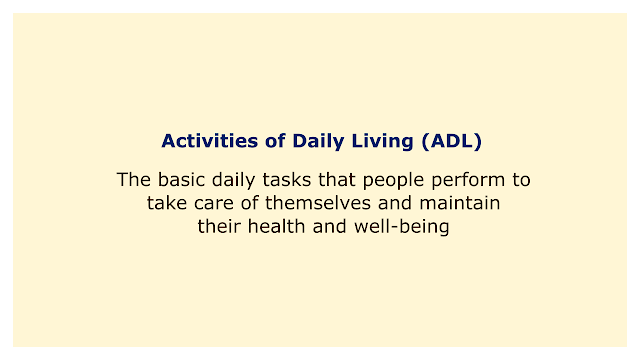 |
| Image: Moneybestpal.com |
Activities of Daily Life (ADLs) are the regular, everyday tasks that people must complete in order to take care of themselves, maintain their health, and be happy.
The activities of daily living (ADLs) include things like grooming, eating, transferring, and bathing. To live safely and independently at home or in the community, several activities are necessary.
The ability to do ADL can be measured and evaluated in a variety of ways. The Katz Index of Independence in Activities of Daily Life, which offers a score from 0 to 6 based on how many ADL a person can complete without assistance, is one of the most popular approaches. The level of independence and functioning is indicated by the score.
The Lawton Instrumental Activities of Daily Life Scale is another tool that assesses more difficult but crucial jobs for contemporary society. These activities include handling money, using the phone, going shopping, cooking, cleaning, doing laundry, taking medication, and using transportation. These duties, which are often referred to as Instrumental Activities of Daily Living (IADL), demonstrate a person's capacity to meet environmental and interpersonal demands.
A person's health status, quality of life, and need for care can all be determined by looking at their ADLs and IADLs. They can assist in identifying issues or dangers that could jeopardize a person's health and safety, such as cognitive decline, physical handicap, mental illness, or social isolation. They can also assist in determining the proper level and kind of care that a person might need, such as home care, assisted living, nursing homes, or hospice.
Caregivers and medical professionals can better support patients and intervene to help them preserve or enhance their functioning and independence by observing and analyzing a person's ADL and IADL. Also, they can aid in preventing or delaying issues and negative outcomes that could arise from a deterioration in ADL and IADL, such as falls, infections, undernutrition, depressive symptoms, or institutionalization.
The ability to do ADL can be measured and evaluated in a variety of ways. The Katz Index of Independence in Activities of Daily Life, which offers a score from 0 to 6 based on how many ADL a person can complete without assistance, is one of the most popular approaches. The level of independence and functioning is indicated by the score.
The Lawton Instrumental Activities of Daily Life Scale is another tool that assesses more difficult but crucial jobs for contemporary society. These activities include handling money, using the phone, going shopping, cooking, cleaning, doing laundry, taking medication, and using transportation. These duties, which are often referred to as Instrumental Activities of Daily Living (IADL), demonstrate a person's capacity to meet environmental and interpersonal demands.
A person's health status, quality of life, and need for care can all be determined by looking at their ADLs and IADLs. They can assist in identifying issues or dangers that could jeopardize a person's health and safety, such as cognitive decline, physical handicap, mental illness, or social isolation. They can also assist in determining the proper level and kind of care that a person might need, such as home care, assisted living, nursing homes, or hospice.
Caregivers and medical professionals can better support patients and intervene to help them preserve or enhance their functioning and independence by observing and analyzing a person's ADL and IADL. Also, they can aid in preventing or delaying issues and negative outcomes that could arise from a deterioration in ADL and IADL, such as falls, infections, undernutrition, depressive symptoms, or institutionalization.
